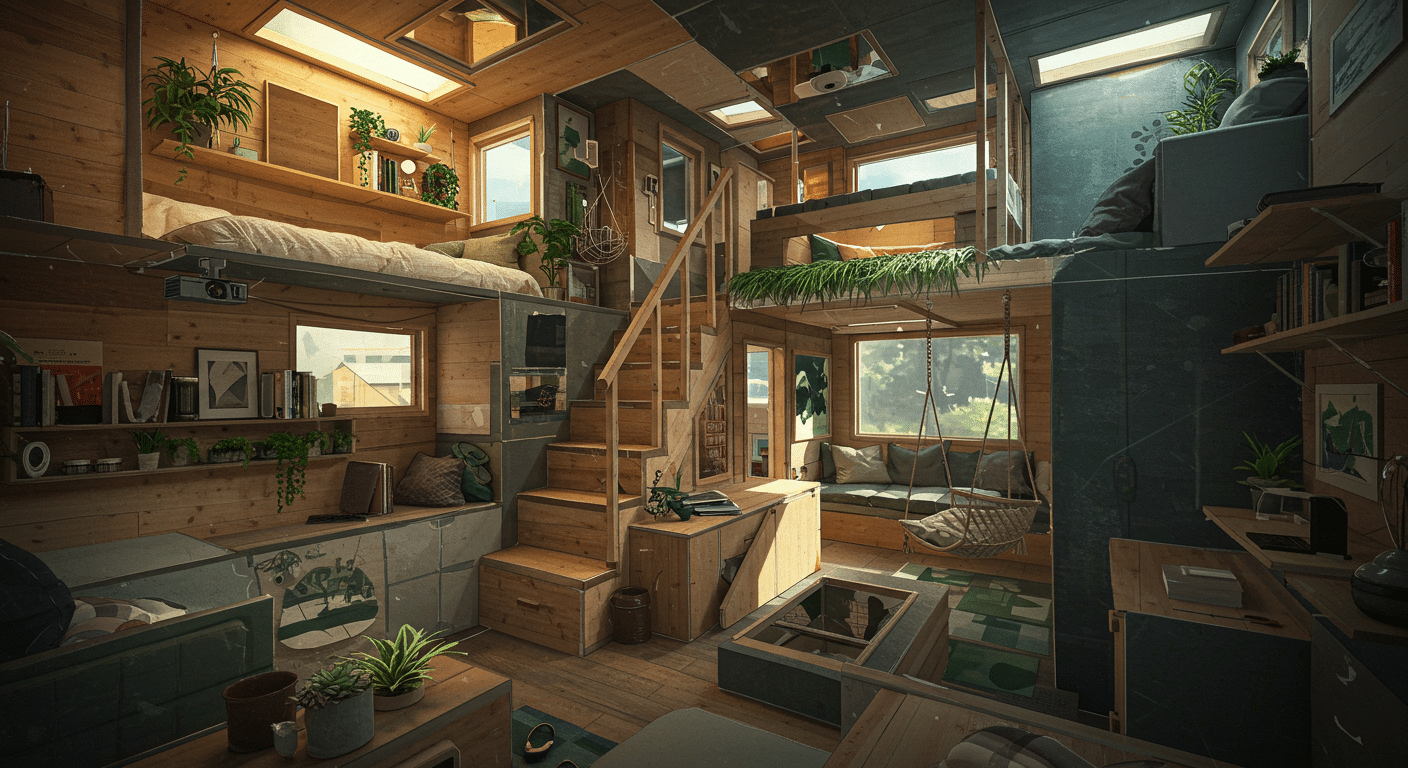Tiny houses don’t ask for much, but they do ask for creativity. Especially when you’re working with an elevated living room—those cozy, tucked-up spaces that feel like little treehouses inside your home. They’re charming, but they also come with design puzzles that make you stop and go, “huh.” Every square inch counts. Every corner has to carry its weight. So instead of stuffing your living space with oversized furniture and regret, let’s get smart about it. There’s a kind of joy in designing small. It forces you to think harder and live lighter. These 22 clever ideas aren’t just Pinterest fluff—they’re tested, thoughtful tweaks that make elevated living spaces not only work, but wow. Ready? Let’s rethink the tiny living room, one elevated inch at a time.
1. Build Storage Into the Stairs
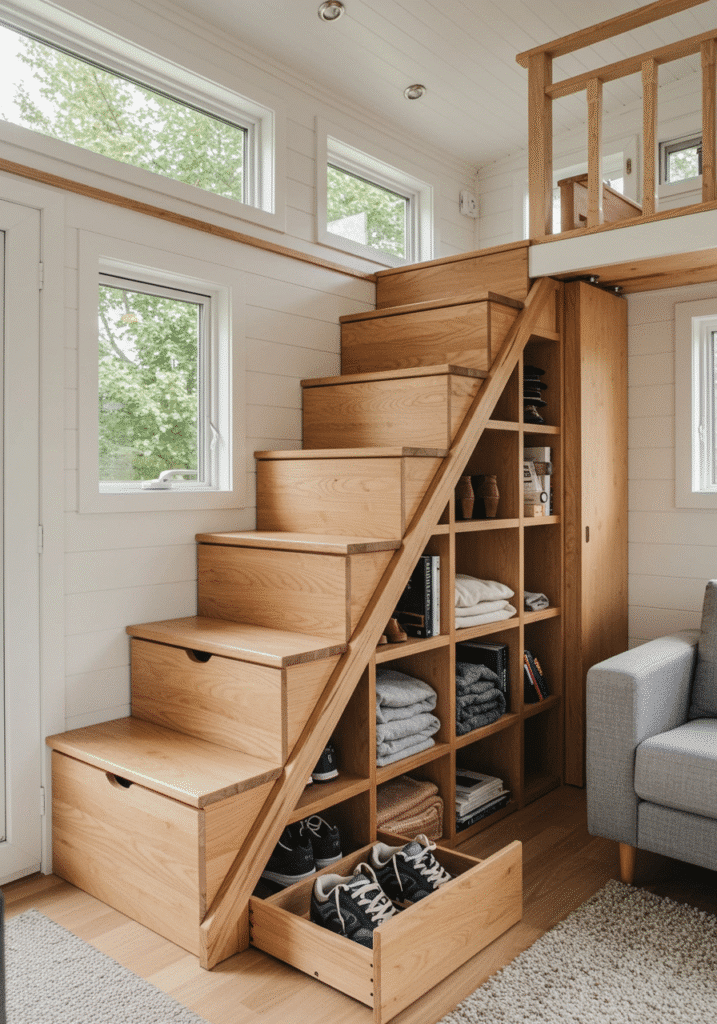
In a tiny house, stairs aren’t just stairs—they’re untapped goldmines of space. Instead of letting the area beneath your steps collect dust bunnies and old socks, you can convert each stair into a functional drawer. These stair drawers can hold anything from winter sweaters to books to the dog’s endless toy collection. It’s storage that doesn’t look like storage, which is key when you’re trying to maintain clean lines in a tight space. You can even add custom handles or latches to make them blend right in. Got more than a few steps? Even better—you’ve just scored an entire dresser worth of hidden storage. And let’s be real, having a place to stash clutter without anyone noticing is kind of a power move. Plus, there’s something weirdly satisfying about pulling open a stair to reveal snacks. It’s clever, clean, and completely practical. Stairs don’t just take you somewhere—they hold everything you take with you.
2. Platform Seating With Storage Beneath
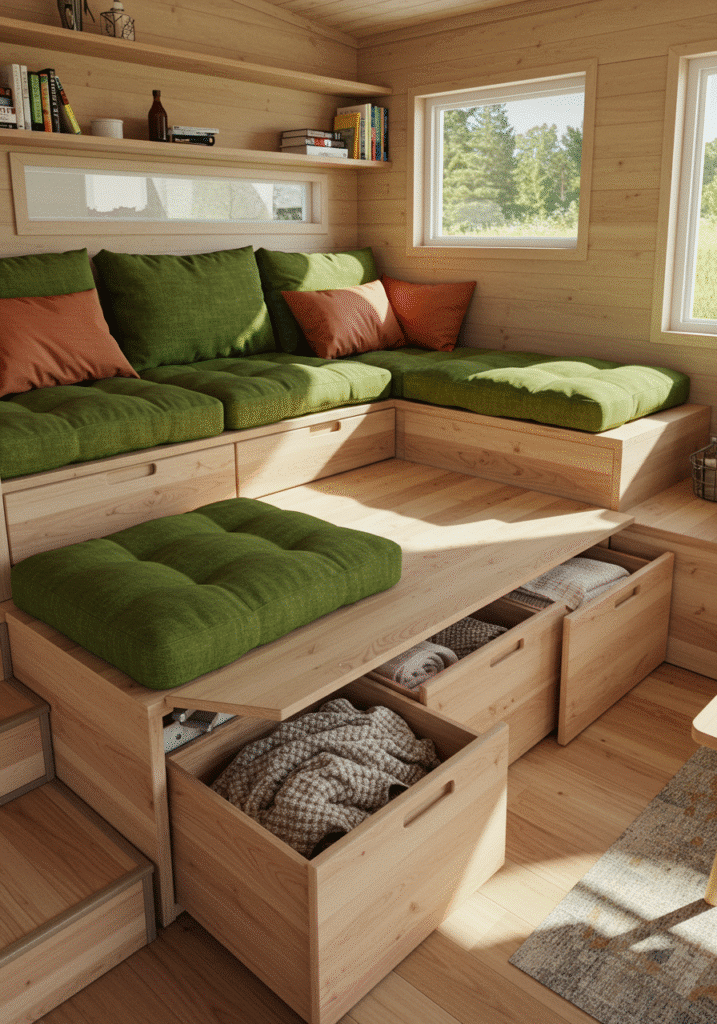
Platform seating is a total game-changer for elevated rooms. You can build a raised wooden base that acts like a stage for your entire lounging area. On top, you layer it with comfy cushions, a few throw pillows, and maybe a wool blanket that makes you feel fancier than you actually are. Underneath? That’s where the real magic happens. Add deep storage drawers or lift-up panels that give you access to hidden compartments. You can stash bedding, off-season clothes, board games, or all the stuff you pretend you’ve decluttered. It’s a smart way to combine seating and storage without breaking up the flow of the room. Bonus: a platform creates a sense of separation and coziness, like a tiny living room island. You feel tucked away, even in a small open-concept layout. Form meets function and they both win.
3. Install a Hanging Chair
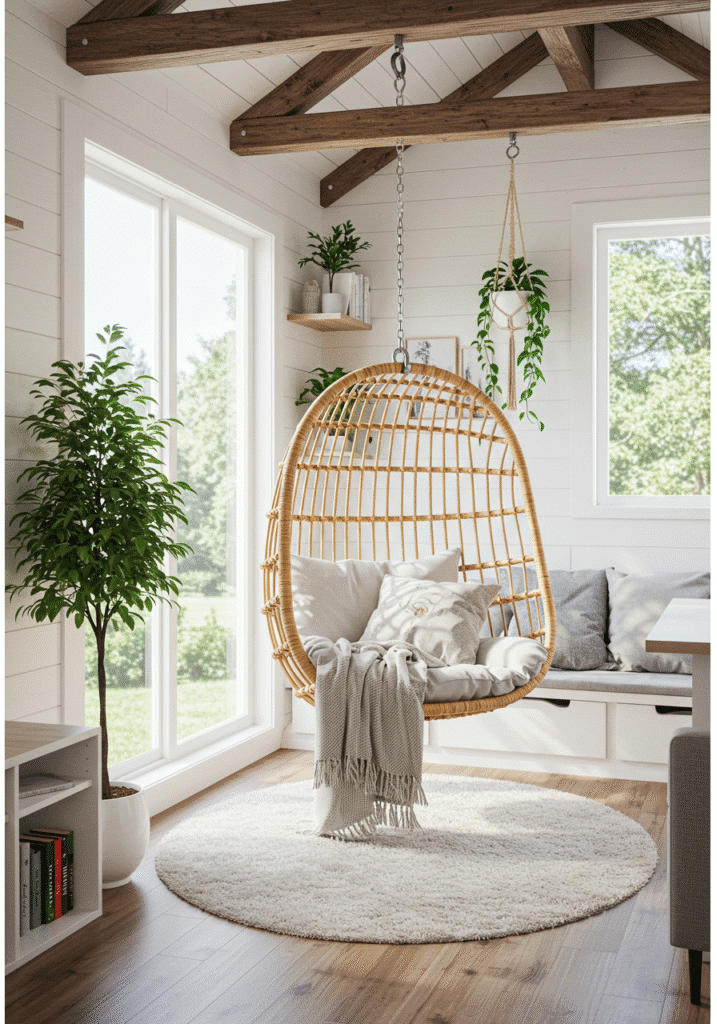
A hanging chair brings a little magic into your elevated space—it’s got style, movement, and that “look at me” vibe without actually hogging any floor space. The moment someone walks into your tiny living room and sees a chair floating from the ceiling, they know this house means business. It’s not just a seat—it’s a statement. Plus, because it doesn’t sit on the ground, it keeps the room feeling light and open. Hang it in a corner and suddenly that dead zone becomes everyone’s favorite nook. Choose one with a cozy cushion or a macramé design for an added texture boost. It’s fun, functional, and kind of makes you feel like you’re on vacation. Just make sure the ceiling beam is sturdy—swinging into drywall is nobody’s idea of a good time. A hanging chair might not seem essential, but once you’ve got one, you’ll wonder how you ever lounged without it.
4. Wall-Mounted Projector Instead of a TV

In a tiny house, big TVs can dominate the space and mess with the vibe. That’s why a wall-mounted projector is a sleek solution that feels futuristic without being fussy. You mount the projector up high, pull down a screen or use a white wall, and instantly your whole living room becomes a movie theater. No bulky entertainment center needed. When you’re not watching anything, the screen rolls away and the room looks bigger. It’s especially genius for elevated spaces where you might not have the depth for a full TV setup. You also avoid all those tangled cords and sad remote control piles. Watching movies up in your loft feels like your own secret cinema. The ambient glow adds mood, and the space still looks clean when you shut it off. It’s minimal, magical, and way more immersive than a TV in a cabinet.
5. Use Sliding or Pocket Doors

Traditional swinging doors are space hogs. In a tiny elevated area, they can make things feel cramped or even block furniture. Enter the pocket door: a smooth, space-saving hero that slides right into the wall. Or a barn-style sliding door, if you’re into that rustic-modern mix. These doors don’t just save space—they add architectural interest. They’re especially helpful if your elevated room has an entryway you want to section off sometimes for privacy. You can even add frosted glass panels for light while keeping things private. They’re easier to install than most people think and make your space look 10x more custom. Instead of opening outward into a chair or table, your door just… disappears. It’s one of those upgrades that makes a small home feel smart instead of squeezed.
6. Use Mirrors to Fake More Space

Mirrors are basically magic tricks for small rooms. They reflect light, double the visual size of a space, and give the illusion that the room keeps going. In an elevated living room, a large mirror on the wall can instantly make it feel less boxed in. If you’re feeling bold, go for a floor-to-ceiling mirror—it’ll open the space right up. Hanging mirrors behind furniture, like the couch or a console table, helps bounce natural light around. You can even lean a tall mirror in the corner for a more casual, modern look. Go with a funky frame if you want to add personality. The key is placement: think opposite a window or facing the room’s best view. It’s décor that earns its keep and keeps your space from feeling claustrophobic.
7. Floating Shelves Overhead
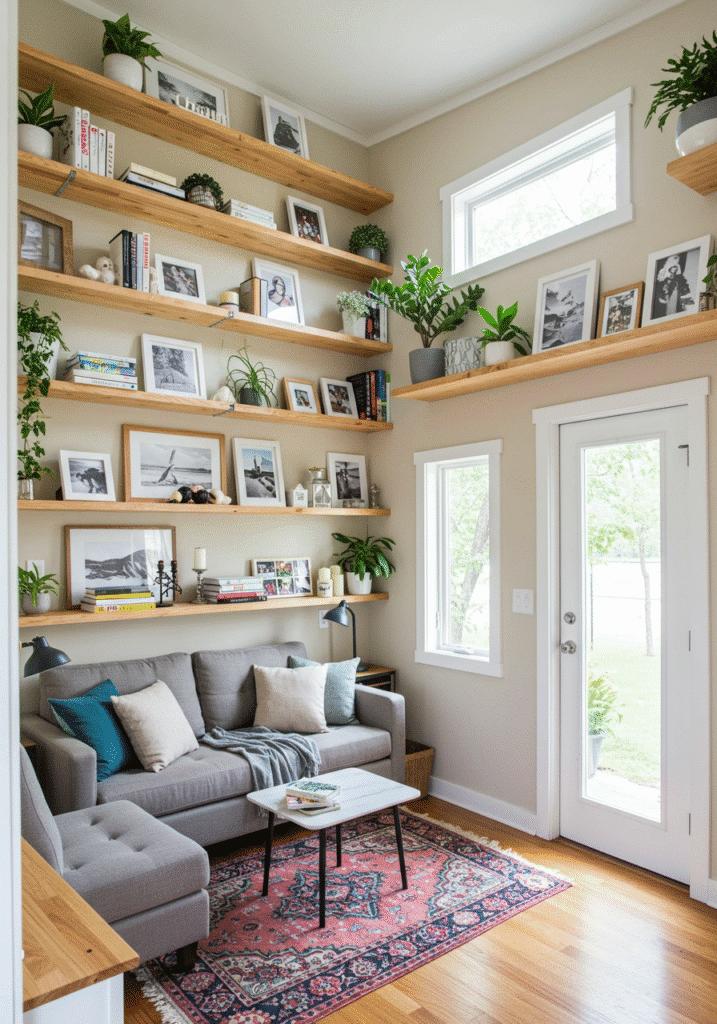
Floating shelves are like the Swiss army knife of tiny homes—they’re minimal, useful, and surprisingly good-looking. In an elevated living room, where you don’t want to close things in with bulky bookcases, floating shelves give you storage without the weight. Pop them up near the ceiling or above windows and suddenly you’ve got a place for plants, books, candles, and random cool-looking stuff you don’t actually use. They keep clutter off the floor while making your walls work harder. Plus, they help draw the eye upward, which makes the ceiling feel taller than it actually is. You can use reclaimed wood or painted boards to match your style, whether it’s cozy cabin or minimalist chic. Just don’t overcrowd them—you’re aiming for curated, not chaotic. They’re great for showing off a collection or hiding your mess behind a few wicker baskets. Floating shelves might look delicate, but they punch way above their weight in a small space. And bonus: you’ll feel smug about how organized you are.
8. Loft Railings That Double as Bookshelves
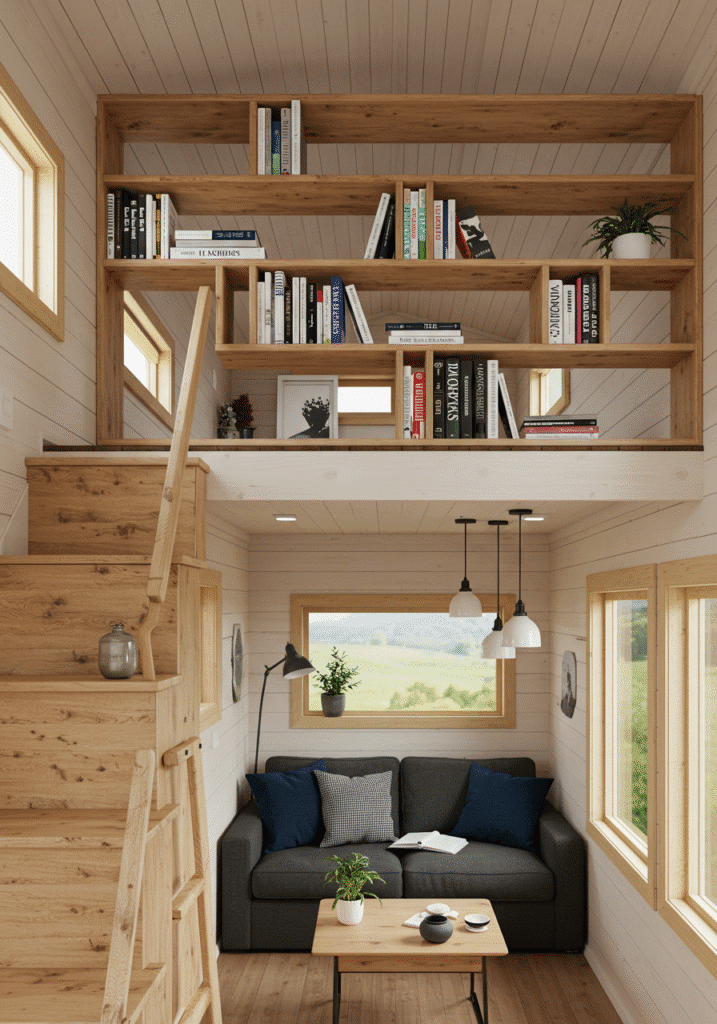
Why settle for a plain railing when it could hold your favorite stories? In an elevated living room, your loft railing doesn’t have to be boring—it can be a built-in bookshelf that adds function and charm. These custom railings give you a place to keep books, plants, or even your vinyl collection within arm’s reach. You’re basically building a library into your living room without taking up any extra room. It also adds a sense of coziness—there’s something intimate about being surrounded by books while you lounge. You can build them low and wide, or tall and narrow, depending on how much stuff you want to store. Add a reading light nearby and you’ve got yourself a mini book nook in the sky. Safety meets storage meets style—who knew a railing could do so much? Plus, they’re a great way to show off your personality. Your books say a lot about you—and in a tiny house, every detail should speak.
9. Modular Furniture That Moves

In small elevated spaces, flexibility is key. Modular furniture lets you shift your setup depending on your mood, your needs, or how many guests show up uninvited. Ottomans become coffee tables. Cushions become guest beds. A single piece can serve three different purposes without blinking. That kind of multitasking is exactly what a tiny house demands. You don’t need a massive sectional—just a few well-designed pieces that click together like Legos. Bonus points if they have hidden storage. Being able to rearrange your layout on a whim keeps the space feeling fresh, not fixed. And it means you can clear the floor when it’s time for yoga, dance parties, or a dramatic cry session. Modular means mobile, and mobile means magic in tiny living.
10. Fold-Down Wall Desks
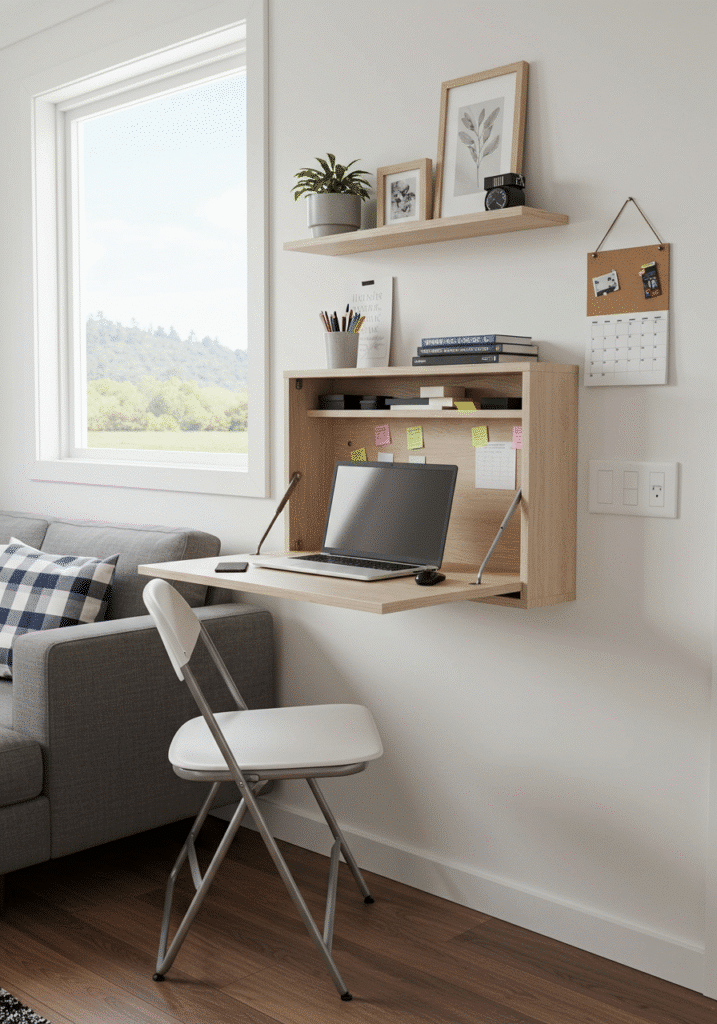
If your elevated living room doubles as your office—or your occasional “pretend to be productive” space—then a fold-down wall desk is a lifesaver. It stays tucked away when you don’t need it and flips down in seconds when inspiration strikes. You get a sturdy, flat surface for your laptop, notebook, or coffee (probably all three), and then poof, it’s gone again. The best part? No need to trip over furniture that’s only useful part-time. These desks can be custom-built to match your wall or made from salvaged wood for that rustic-meets-clever vibe. You can even mount a cork board or art behind it, so it feels like part of your decor when closed. For work-from-home folks in a tiny house, this desk is gold. It helps you separate chill time from work time without needing a separate room. Fold-down desks are proof that you don’t need more space—just smarter stuff.
11. Use Rugs to Define Zones

Open spaces can blur together in tiny homes, especially in an elevated layout. Rugs are your secret weapon—they divide, define, and decorate all in one go. A well-placed rug anchors your living room, giving it a visual boundary without adding walls. It says, “this is where we relax,” even if your kitchen is only four feet away. Rugs add warmth and texture too, softening up all those hard surfaces like wood and metal. Go for bold patterns or subtle tones depending on your style, but size is key—get one large enough to sit under at least two legs of your furniture. That helps tie everything together. Layering rugs can also make your space look more curated and less catalog. It’s a low-commitment way to add color and coziness. And hey, it feels nice under your feet. What more could you want?
12. Vertical Gardens for Lush Vibes

Tiny homes need greenery, but you don’t always have the luxury of floor space for plant stands. Enter the vertical garden—your leafy solution to space-starved design. A few mounted planters, a trellis, or hanging pockets let you grow herbs, vines, or flowers right on your wall. It adds texture, color, and freshness to your elevated living room without eating up square footage. Plants naturally soften the feel of a room, especially if you’re working with lots of wood or industrial materials. Plus, they improve air quality—your brain and lungs will thank you. You can go high-maintenance with a full green wall or keep it simple with a few trailing pothos. Either way, vertical gardening turns your walls into living art. And it makes your tiny space feel more alive. Even if you’re a self-proclaimed plant killer, there’s something green for you.
13. Pull-Out Couches for Guests
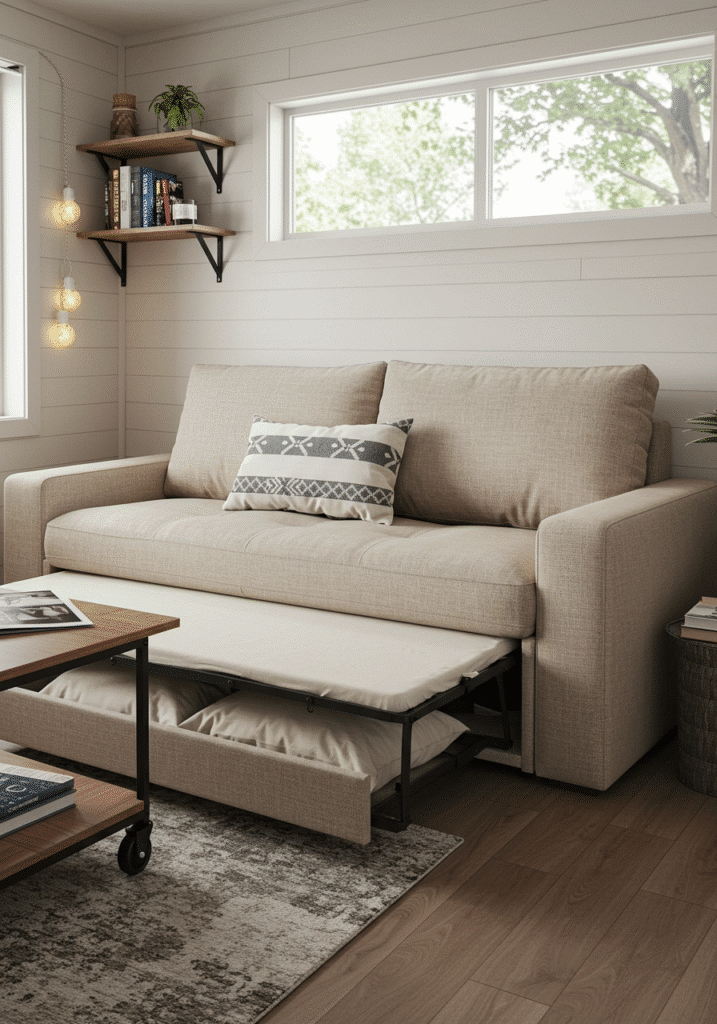
Having guests over in a tiny house can feel like a game of adult Tetris. That’s where a pull-out couch earns its stripes. It’s comfy during the day and transforms into a full sleeping spot by night. No need to stash an extra mattress or awkward inflatable bed. Many modern sofa beds are sleek, supportive, and way less ugly than they used to be. Some even have built-in storage for pillows and blankets—total bonus. It’s a great way to make your elevated living room double as a guest suite. When it’s not in use, it’s just your regular lounging spot, no different than any other couch. The trick is choosing one that fits your style and doesn’t overwhelm the space. Look for slim arms, low backs, and neutral tones if you want it to blend right in. Hosting guests shouldn’t mean giving up your living room—it should mean sharing it smartly.
14. Tall Windows for Sky Views
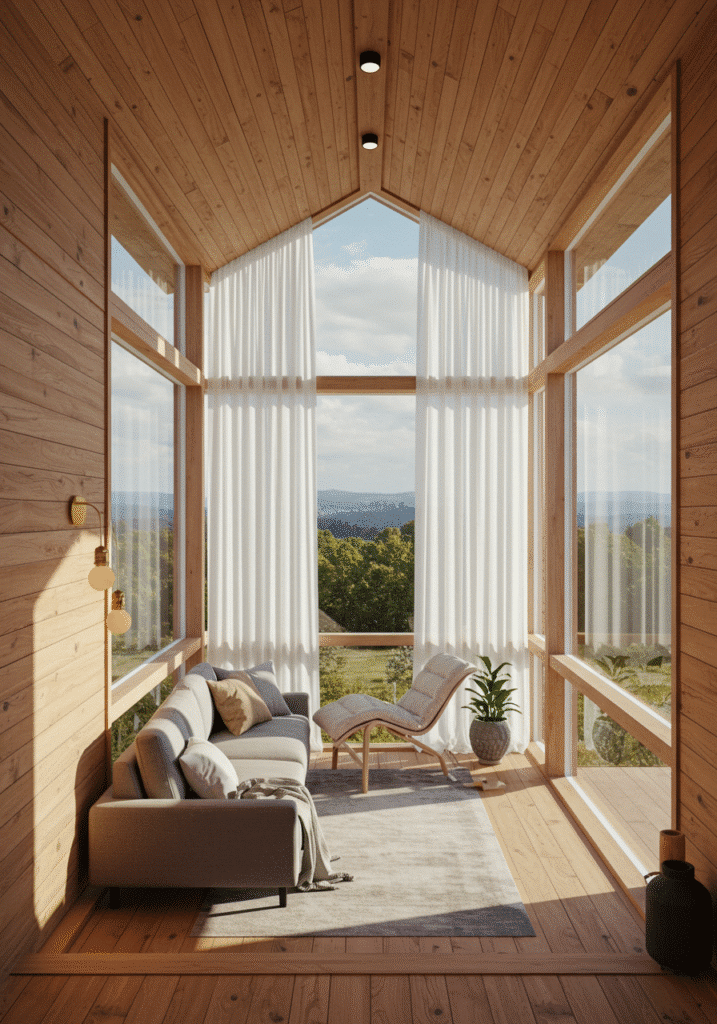
Tiny house living rooms—especially the elevated ones—need light like plants need water. If you’ve got a raised living space, you’re in the perfect spot to use tall windows. The kind that stretch up and flirt with the ceiling, letting every drop of sunshine spill in. Big windows trick your brain into thinking a small space is actually larger than it is. They draw your eye up, which creates a feeling of height and airiness. You don’t need a cathedral—just a few vertical panes and boom, you’re floating. Bonus points if you get views of trees, skies, or even just your garden gnome. Curtains? Optional. Let the light do the decorating. You might not have square footage, but you’ve got sky—and that’s a pretty decent trade.
15. Built-In Benches with Storage
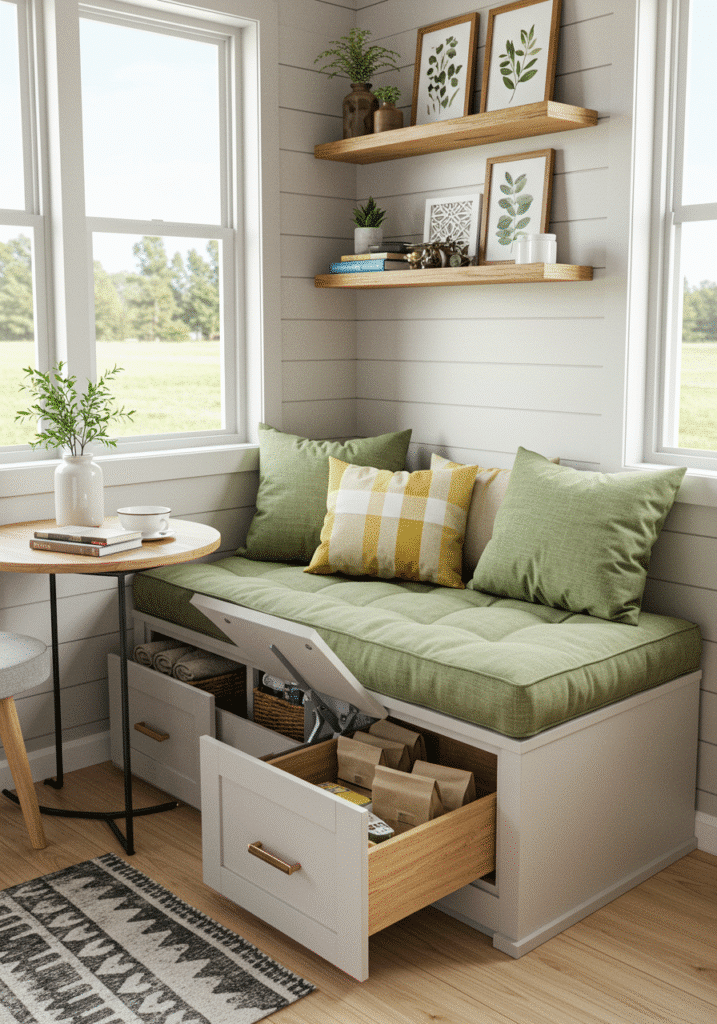
Why buy a couch when you could build one that secretly hoards your clutter? A built-in bench with a lift-up seat is like the Mary Poppins bag of furniture. It’s seating, it’s storage, and it’s sleek all in one. In elevated living rooms, built-ins help you define space without adding bulk. You can tuck baskets, books, off-season throws, or even board games underneath without anyone being the wiser. Build one along a wall or below a window for a cozy reading spot. You’ll feel like you’re in a Scandinavian ski lodge—without the flight. Plus, built-ins give your space a custom, thoughtful feel. It’s not just a house, it’s your house. And your house should be clever like that.
16. Pocket Doors to Save Space
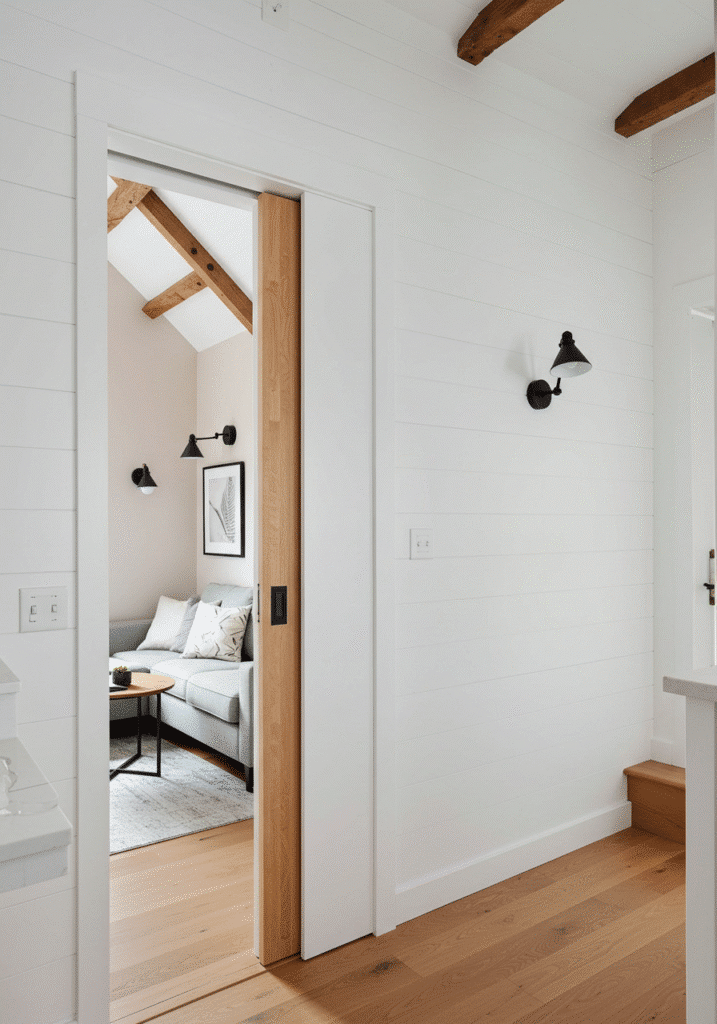
Doors that swing open are fine until they start eating up your precious square footage. That’s where pocket doors come in, sliding quietly into the wall like a magician’s disappearing act. In a tiny elevated living room, they let you separate spaces without making things cramped. They’re especially handy if your living room connects to a loft, office, or bathroom. Want privacy? Slide. Done with people? Slide again. You get all the function of a wall with none of the space sacrifice. Bonus: they look sleek and modern without trying too hard. And if you paint them the same color as your wall, they basically vanish when closed. Pocket doors are the ultimate “I live smart” flex.
17. A Ladder That’s More Than a Ladder

Most tiny homes with lofts have ladders—but that doesn’t mean yours has to be boring. What if your ladder also held your shoes, books, or your hoodie collection? Wall-mounted ladders with hooks or built-in rungs can double as storage or display. And a ladder that’s on wheels? Even better. Slide it out when you need it, roll it away when you don’t. Stash plants or fairy lights on the side to make it part of the decor instead of a clunky necessity. You can go rustic with reclaimed wood or go sleek with metal and leather. Either way, it’s not just a way up—it’s a way to show off your style. A ladder with personality? Yup, that’s a thing now.
18. Accent Walls That Add Texture
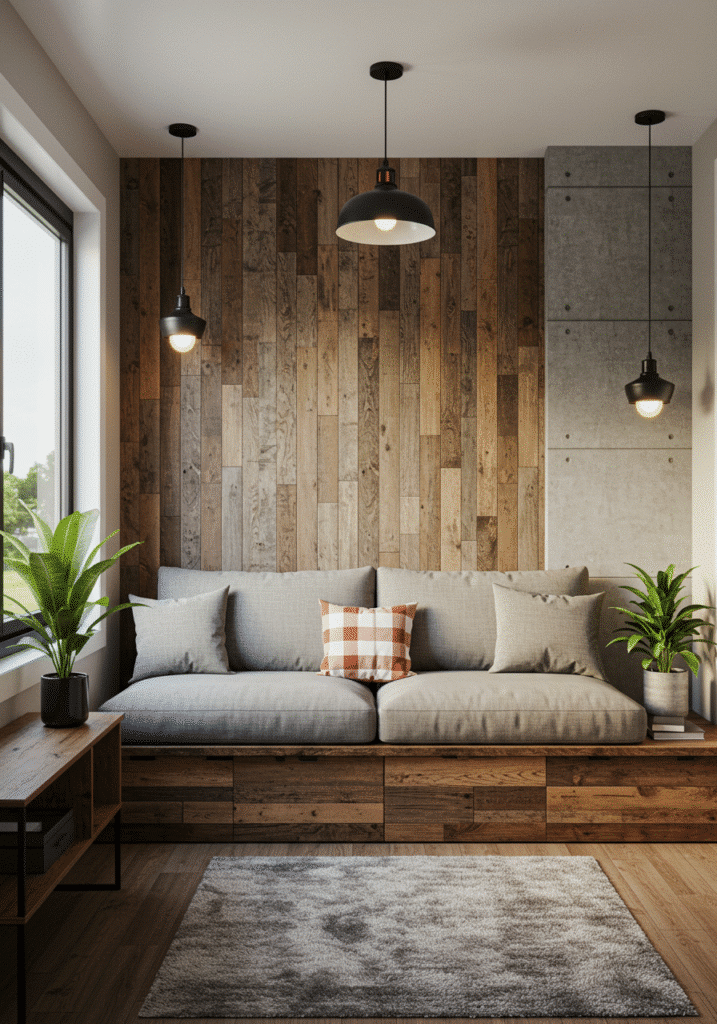
When everything’s tiny, a little drama goes a long way. An accent wall adds texture, color, or even mood to your elevated living room without overwhelming it. Shiplap, wallpaper, peel-and-stick brick—it’s all fair game. Choose one wall and make it pop. Suddenly the whole space feels like it has depth and character. You could go with a deep navy blue, a forest green, or even bold botanical prints if you’re feeling brave. It’s like putting a frame around your living room without the bulk. Accent walls also help zone a space, especially when your kitchen and living area blur together. And guess what? You can always change it later if you get bored. Tiny doesn’t have to mean timid.
19. Built-In Media Nooks
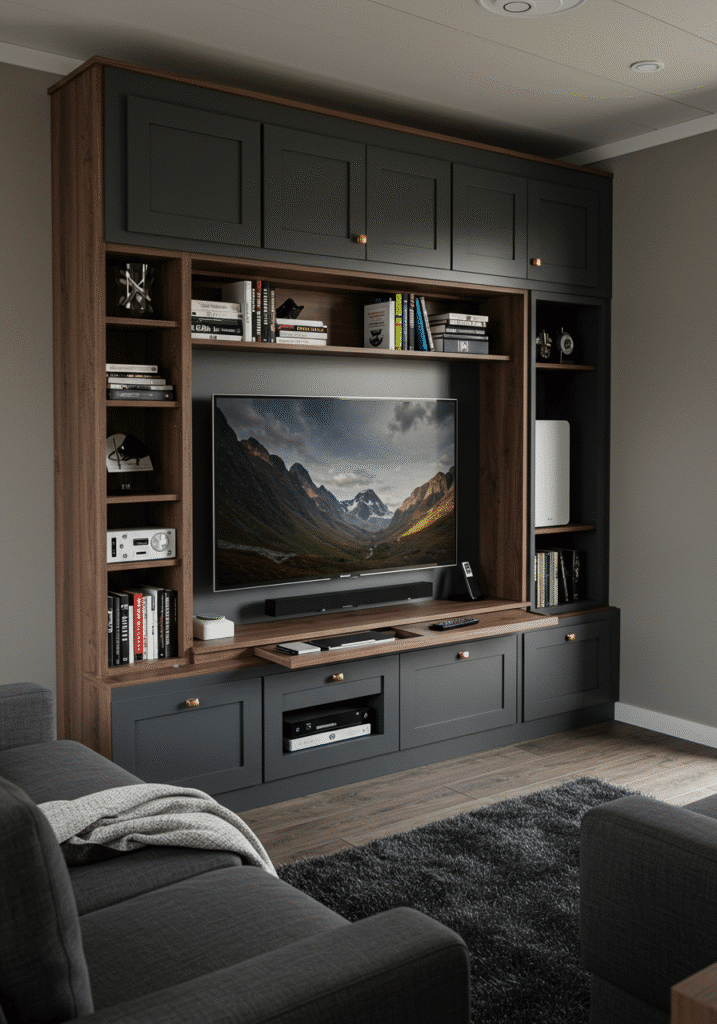
Entertainment units are cool, but in tiny homes, they’re often just a big ol’ nope. Instead, carve out a little media nook into your wall or built-in shelves. Mount your screen, hide the wires, and stash your gadgets in sneaky compartments. Voila—tech without the tangle. You keep your floor space clear and still get your Netflix fix. These nooks make your living room feel intentional and sleek instead of like a tech dumping ground. Add some LED strip lights or a small soundbar to dial up the cozy factor. It’s like a home theater got squished down into something way cuter. No eyesore, no mess, just vibes and binge sessions. Minimal but mighty.
20. Overhead Loft Hammocks
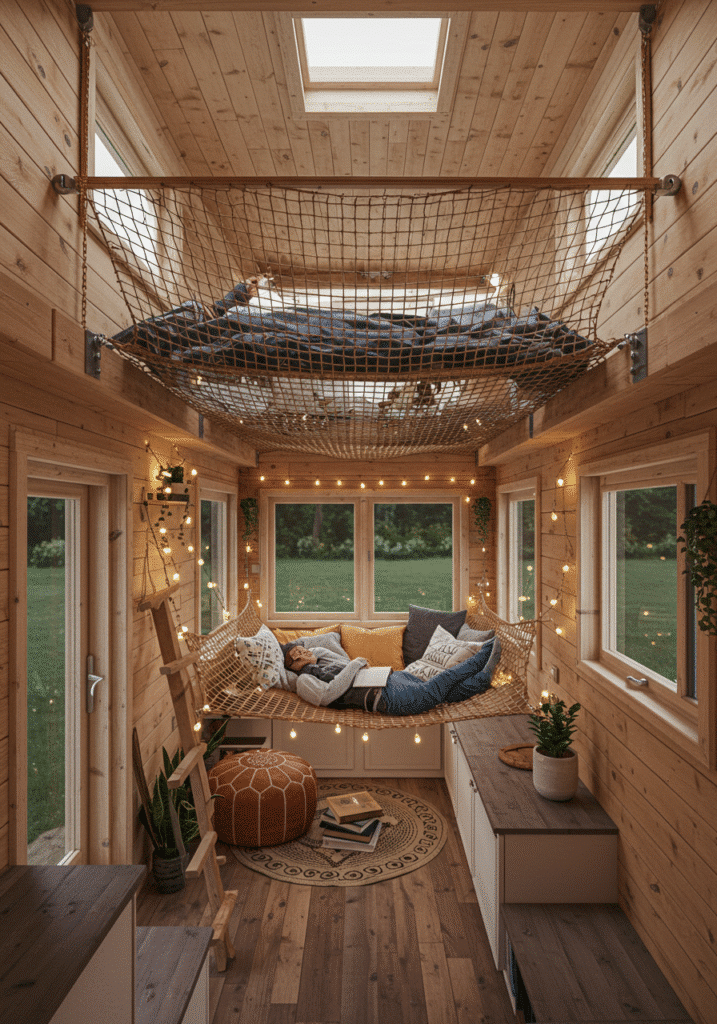
Okay, hear us out: hammocks in your living room. Not the tropical, sand-between-your-toes type—but the cool netted kind that stretch across your loft space like a dreamy suspended cocoon. They let light through, double as a chill zone, and bring serious wow factor to your home. In an elevated room, they make use of the actual air between floor and ceiling. You can lie up there with a book, your phone, or just stare dramatically at nothing. Bonus: they’re a hit with kids and pets. And they don’t take away any walking space since they’re up in the air. Make sure it’s securely mounted though—you don’t want your guests taking a surprise dive. Hammocks up high? It’s the future of lazy.
21. Custom Window Seating
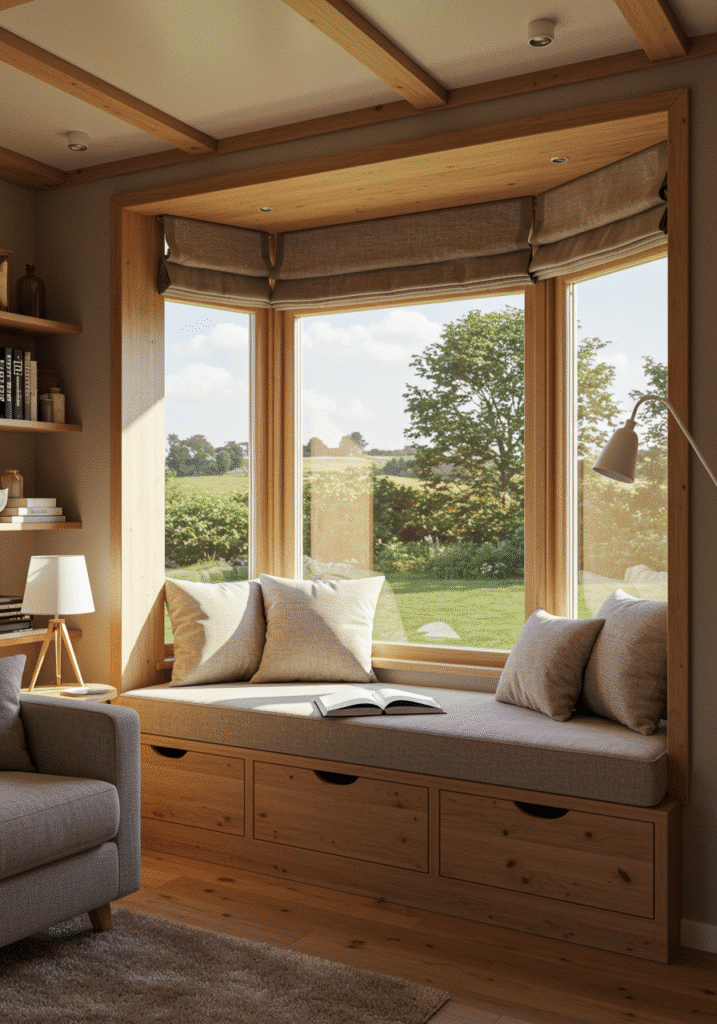
If your elevated living room has windows (and we really hope it does), then you’ve got prime real estate for a window seat. It’s like the cherry on top of your cozy cake. Build in a seat with storage underneath, toss in a few squishy pillows, and you’ve got an instant chill zone. Great for reading, people-watching, or just pretending you’re in a movie montage. You can size it to fit one person—or squeeze in two if you don’t mind elbow wars. Paint it the same color as your wall or contrast it for a little visual pop. Add curtains or shades for privacy without blocking the light. It’s a moment of calm in a compact space. Like a sigh, but made out of fabric and wood.
22. Skylights for Star Gazing

Let’s wrap it up with a bang: skylights. They’re the crown jewel of any elevated tiny living room. Sunlight pours in during the day, stars wink at you by night—what’s not to love? In small homes, ceilings are your best untapped asset. A skylight draws attention upward, expands your view, and fills your space with natural light. It makes everything feel bigger, brighter, and just a bit magical. Even a small one makes a huge difference. You wake up to the sky and go to sleep under the stars. Tiny home or not, that’s something pretty special. And honestly? It feels like your roof has a soul.
Final Thoughts
Living small doesn’t mean living less. With a bit of clever thinking, an eye for cozy detail, and a love for well-used corners, your tiny elevated living room can become the heart of your home. Whether it’s hiding storage in plain sight, adding dramatic views through tall windows, or just creating a comfy place to flop, these 22 ideas are here to stretch your space and your imagination.
Tiny but mighty, friend. Always.

Dorothy is a design lover on a mission to make every space feel inspired — from cozy living rooms to stylish home offices. With a flair for blending comfort, creativity, and practical ideas, she shares decor tips that breathe life into homes, workspaces, and everything in between. Whether you’re revamping a bedroom or refreshing your office nook, Dorothy’s thoughtful ideas help you design spaces that reflect your unique style.
